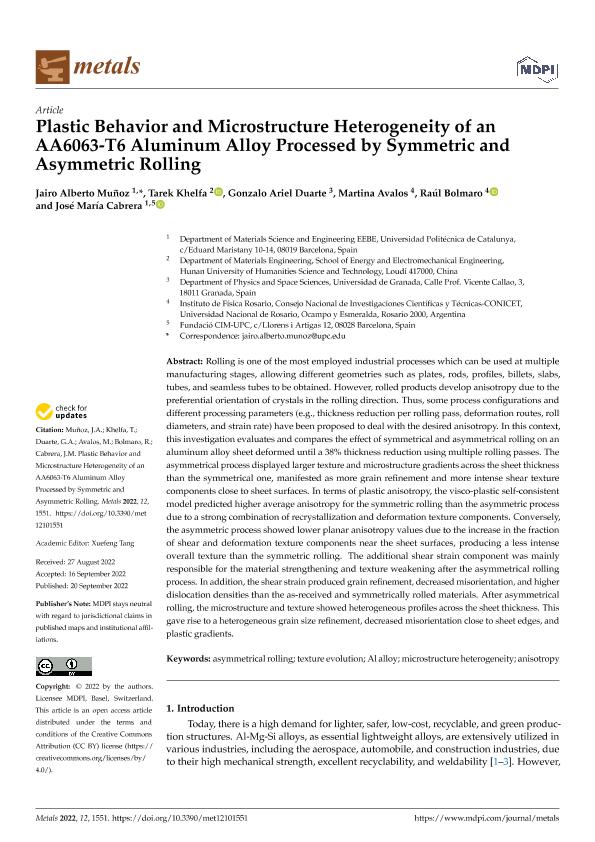Mostrar el registro sencillo del ítem
dc.contributor.author
Muñoz, Jairo Alberto
dc.contributor.author
Khelfa, Tarek
dc.contributor.author
Duarte, Gonzalo Ariel
dc.contributor.author
Avalos, Martina Cecilia

dc.contributor.author
Bolmaro, Raul Eduardo

dc.contributor.author
Cabrera, José María
dc.date.available
2023-11-15T16:05:39Z
dc.date.issued
2022-10
dc.identifier.citation
Muñoz, Jairo Alberto; Khelfa, Tarek; Duarte, Gonzalo Ariel; Avalos, Martina Cecilia; Bolmaro, Raul Eduardo; et al.; Plastic Behavior and Microstructure Heterogeneity of an AA6063-T6 Aluminum Alloy Processed by Symmetric and Asymmetric Rolling; MDPI; Metals; 12; 10; 10-2022; 1-20
dc.identifier.issn
2075-4701
dc.identifier.uri
http://hdl.handle.net/11336/218215
dc.description.abstract
Rolling is one of the most employed industrial processes which can be used at multiple manufacturing stages, allowing different geometries such as plates, rods, profiles, billets, slabs, tubes, and seamless tubes to be obtained. However, rolled products develop anisotropy due to the preferential orientation of crystals in the rolling direction. Thus, some process configurations and different processing parameters (e.g., thickness reduction per rolling pass, deformation routes, roll diameters, and strain rate) have been proposed to deal with the desired anisotropy. In this context, this investigation evaluates and compares the effect of symmetrical and asymmetrical rolling on an aluminum alloy sheet deformed until a 38% thickness reduction using multiple rolling passes. The asymmetrical process displayed larger texture and microstructure gradients across the sheet thickness than the symmetrical one, manifested as more grain refinement and more intense shear texture components close to sheet surfaces. In terms of plastic anisotropy, the visco-plastic self-consistent model predicted higher average anisotropy for the symmetric rolling than the asymmetric process due to a strong combination of recrystallization and deformation texture components. Conversely, the asymmetric process showed lower planar anisotropy values due to the increase in the fraction of shear and deformation texture components near the sheet surfaces, producing a less intense overall texture than the symmetric rolling. The additional shear strain component was mainly responsible for the material strengthening and texture weakening after the asymmetrical rolling process. In addition, the shear strain produced grain refinement, decreased misorientation, and higher dislocation densities than the as-received and symmetrically rolled materials. After asymmetrical rolling, the microstructure and texture showed heterogeneous profiles across the sheet thickness. This gave rise to a heterogeneous grain size refinement, decreased misorientation close to sheet edges, and plastic gradients.
dc.format
application/pdf
dc.language.iso
eng
dc.publisher
MDPI
dc.rights
info:eu-repo/semantics/openAccess
dc.rights.uri
https://creativecommons.org/licenses/by/2.5/ar/
dc.subject
AL ALLOY
dc.subject
ANISOTROPY
dc.subject
ASYMMETRICAL ROLLING
dc.subject
MICROSTRUCTURE HETEROGENEITY
dc.subject
TEXTURE EVOLUTION
dc.subject.classification
Ingeniería de los Materiales

dc.subject.classification
Ingeniería de los Materiales

dc.subject.classification
INGENIERÍAS Y TECNOLOGÍAS

dc.title
Plastic Behavior and Microstructure Heterogeneity of an AA6063-T6 Aluminum Alloy Processed by Symmetric and Asymmetric Rolling
dc.type
info:eu-repo/semantics/article
dc.type
info:ar-repo/semantics/artículo
dc.type
info:eu-repo/semantics/publishedVersion
dc.date.updated
2023-11-14T14:24:44Z
dc.journal.volume
12
dc.journal.number
10
dc.journal.pagination
1-20
dc.journal.pais
Suiza

dc.description.fil
Fil: Muñoz, Jairo Alberto. Universidad Politécnica de Catalunya; España
dc.description.fil
Fil: Khelfa, Tarek. Hunan University of Humanities Science and Technology; China
dc.description.fil
Fil: Duarte, Gonzalo Ariel. Universidad de Granada; España
dc.description.fil
Fil: Avalos, Martina Cecilia. Consejo Nacional de Investigaciones Científicas y Técnicas. Centro Científico Tecnológico Conicet - Rosario. Instituto de Física de Rosario. Universidad Nacional de Rosario. Instituto de Física de Rosario; Argentina
dc.description.fil
Fil: Bolmaro, Raul Eduardo. Consejo Nacional de Investigaciones Científicas y Técnicas. Centro Científico Tecnológico Conicet - Rosario. Instituto de Física de Rosario. Universidad Nacional de Rosario. Instituto de Física de Rosario; Argentina
dc.description.fil
Fil: Cabrera, José María. Universidad Politécnica de Catalunya; España
dc.journal.title
Metals
dc.relation.alternativeid
info:eu-repo/semantics/altIdentifier/doi/http://dx.doi.org/10.3390/met12101551
Archivos asociados
